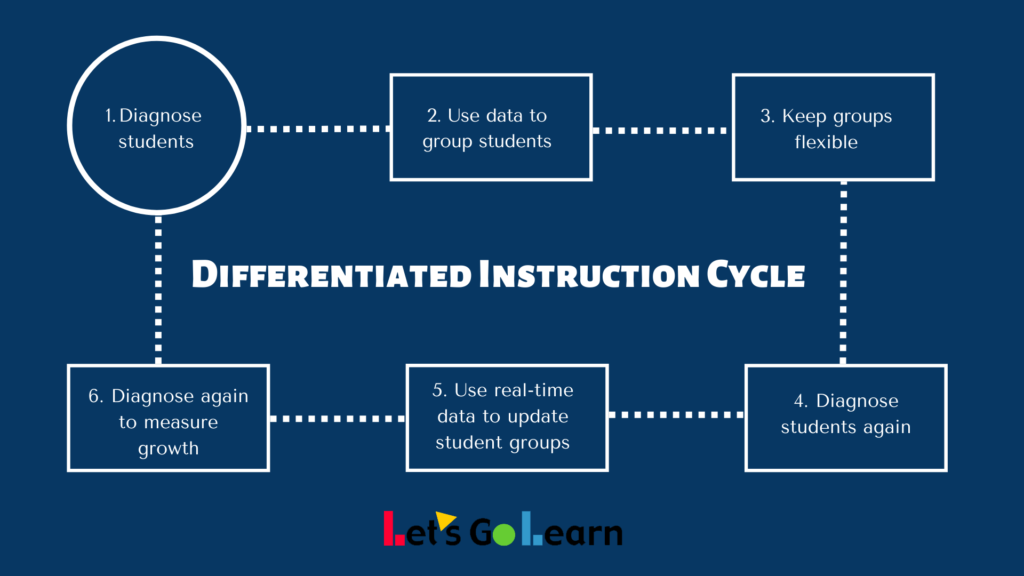What is differentiated instruction?
Differentiated instruction is a teaching strategy which uses different teaching methods for each student, depending on their needs and interests. It can be used with any subject. Differentiated instruction has been around for decades, but its effectiveness has proven elusive to quantify. The promise is sound, but like any other teaching approach, if implemented poorly, the results are underwhelming. But when implemented using best practices, differentiated instruction has powerful benefits.
Learn more about education reform
Does differentiated instruction work?
Relevant studies show that differentiated instruction works, but as with all complex instructional planning, the devil’s in the details. Inconsistent implementation strategies, resource constraints, class sizes, lack of planning time, and a lack of data-driven best practices, have limited the impact of differentiated instruction. But by the early 2000s, edtech (education technology) software and the Web had evolved enough to help educators automate much of the differentiation legwork.
Numerous critics have put doubt in the strategy. A 2005 study by the National Research Center on Gifted and Talented tracked implementations of differentiated instruction over the course of 3 years, but reported that most teachers found it difficult to move away from traditional lectures and student desk project. A 2010 report by the research group McREL showed that “to date, no empirical evidence exists to confirm that the total package [of strategies used in differentiated instruction] has a positive impact on student achievement.” A more recent 2019 retrospective review by Smale-Jacobse, et al, showed that only 38% of teachers’ weekly lessons were differentiated, and “teachers in their sample, on average, did not execute very elaborate differentiated instruction.” This research seems to bolster critics, who believe this instructional approach requires too much teacher training and additional time to be implemented successfully. James Delisle, an advocate of gifted education, argues that differentiated instruction doesn’t go far enough to benefit advanced students. So how do we know differentiated instruction works for those teachers who successfully practice some sort of differentiated instruction?
Differentiated instruction is certainly more challenging in mixed-ability classrooms compared to the lecture-homework model. As University of Virginia researcher Carol Ann Tomlinson noted in her widely cited work, successful differentiated instruction implies that educators and their leaders proactively modify traditional curricula, teaching methods, and student activities, to better meet individual or small group learning needs. The huge drain on resources is naturally why most schools used a one-size-fits-all lecture/desk work model for so many years.

The casual reader might look at the critiques of differentiated instruction and presume the whole notion simply doesn’t work. Or, one could also conclude that differentiated instruction is too difficult to successfully implement. Carol Tomlinson writes, “I absolutely understand that differentiating instruction well is not easy. But then, I’ve never felt that teaching should be easy.” In an essay titled, “Differentiation Does, in Fact, Work,” Tomlinson reminds us of the complexity of lesson planning with different ability levels, the neuroscience behind classroom instruction, and the responsibility all teachers have to provide learning opportunities for individual students. She reminds us that all brains are malleable, and that when teacher expectations are high, students respond.
When done properly, differentiated instruction can have remarkable benefits. Besides the social-emotional benefits of addressing each child’s individual needs through a zone of proximal development, well-conceived differentiated instruction can offer spectacular academic gains. A small study by the Canadian Center of Science and Education saw math scores increase more than 40% simply by using contextual learning strategies. Even in the Smale-Jacobse review noted earlier, with only 38% of teachers successfully implementing some differentiated instruction strategies, “the majority of the studies show small to moderate positive effects of differentiated instruction on student achievement.” Furthermore, research consistently, and not surprisingly, shows that differentiated instruction is effective for students on either end of the ability spectrum: gifted students and students with mild to severe learning disabilities. When students receive instruction appropriate to their zone of proximal development, and especially when they are able to help choose the context of their learning, students are more engaged, happier, less stressed, and cause fewer discipline problems.
Successful differentiated instruction strategies
While differentiated instruction has been around for many decades, it suffered from inconsistent implementations and a lack of empirically-based decisions. In 2010, the US Department of Education proposed a framework (“Transforming American Education: Learning Powered by Technology“) for differentiated instruction while also explaining how the strategy works in the context of individualization and personalization. The framework said that in differentiated instruction, “learning goals are the same for all students, but the method or approach of instruction varies according to the preferences of each student or what research has found works best for students like them.” This document helped provide a starting point for many efforts, and soon many studies were providing empirical data upon which instructional approaches could be based.
At the core of differentiated lessons is the goal of a personalized learning environment which focuses on evidence-based and contextually-appropriate strategies iterated over time. The most efficient and effective way to do this is through the use of edtech software to automate assessment strategies and build individual education plans. This means using diagnostic assessments and real-time progress monitoring to confirm and keep track of the individual information classroom teachers are taught to gather through best practices.
A typical differentiated instruction cycle repeats these steps:
- At the start of a cycle (beginning of school year, summer summer school, etc.), administer a comprehensive diagnostic assessment to understand your students’ strengths and weaknesses.
- Use assessment data to determine commonalities and differences in your students’ abilities.
- Group students according to their competency levels pertinent to the skills you are teaching.
- Groups should be flexible! Mix up your groups! Students should be able to leave a group once a skill is mastered. You can determine mastery along the way by administering skills quizzes, chapter, unit tests, or another type of formative testing. (Tip: Remember that students learn best from their peers.)
- By mid-year, administer another comprehensive diagnostic to measure student progress.
- Use new real-time data to update instructional points and create new flexible groups.
- Continue to differentiate instruction based on student strengths and weaknesses.
- Test once more at the end of a year or cycle to measure progress once more.
A generalized, more condensed cycle is illustrated in this diagram.

Differentiated instruction best practices
The use of edtech software to radically improve and scale the building of individual learner profiles using evidence-based data, was facilitated by the internet. Beginning in 2001, Let’s Go Learn, Inc., pioneered the first online, computer-adapted, diagnostic assessments for K-12 math and reading. These assessments didn’t simply provide teachers with individual standardized achievement scores; through the use of diagnostic assessment, Let’s Go Learn was able to explain the strengths and weaknesses of each student so that the teachers understood why a student performed they way they did. The internet allowed vast quantities of information to be stored and manipulated in real-time across different locations and computers. And software allowed teachers to efficiently utilize pre-assessments and
For over 20 years, Let's Go Learn has been offering best-in-class, personalized assessments in reading and math. See for yourself!
More info...Today, by using a data-driven approach to quantify not only where students stand along their learning path, but why, teachers gain a roadmap for developing a differentiated classroom. Most teachers already do some sort of differentiation of instruction naturally, whether formalized or not. But software helps quantify and scale that differentiation across a classroom quickly and efficiently. When each student has a learner profile driven by data, teachers can focus on the bigger picture, and the individual education experience in which each child thrives. Healthy learning environments which include personalization, real-time progress monitoring and formative assessment, multicultural education components, and student-driven context, provide an excellent differentiated environment.
The individual instructional strategies used to differentiate students vary depending on the students, the teacher, and the resources available. Lesson plans for individual students may include tiered assignments, flexible grouping, different or extra time allotments, adapting the number of tasks, peer tutoring, use of volunteers or assistants, choice boards, graphic organizers, contextual learning, and many other education concepts. All of these strategies must obviously be wrapped around direct instruction, classroom management techniques, and response to intervention (RtI) needs. There’s a lot going on. Periodic classroom assessments help make sure student learning is taking place.
Teachers may also utilize personalized instruction software which builds individual lesson plans for each student based on their diagnostic assessments. This type of supplementary curriculum allows teachers to work within resource constraints so that they can focus on where they can make the bigger impact in their classroom. Let’s Go Learn provides this sort of online software in its Edge curriculum products, which integrate directly with the diagnostic assessments to personalize education for each student.
The goal of creating a differentiated classroom is achievable within most resource constraints. In fact, with the use of edtech software, many constraints are overcome. Educational standards come and go, but by utilizing effective teaching, quality software, evidence-based strategies, and ongoing assessment, a differentiated class leads to academic success.
Additional reading
https://www.edweek.org/teaching-learning/differentiated-instruction-a-primer/2015/01
https://www.prodigygame.com/main-en/blog/differentiated-instruction-strategies-examples-download/
https://www.edweek.org/teaching-learning/opinion-differentiation-does-in-fact-work/2015/0


Leave A Comment